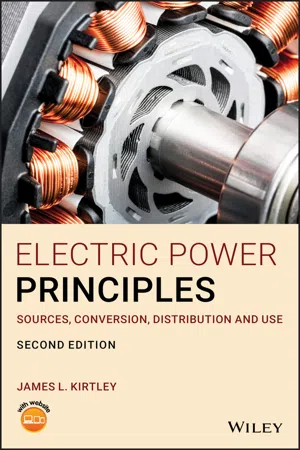
- English
- ePUB (mobile friendly)
- Available on iOS & Android
About this book
A revised and updated text that explores the fundamentals of the physics of electric power handling systems
The revised and updated second edition of Electric Power Principles: Sources, Conversion, Distribution and Use offers an innovative and comprehensive approach to the fundamentals of electric power. The author – a noted expert on the topic – provides a thorough grounding in electric power systems, with an informative discussion on per-unit normalisations, symmetrical components and iterative load flow calculations. The text covers the most important topics within the power system, such as protection and DC transmission, and examines both traditional power plants and those used for extracting sustainable energy from wind and sunlight.
The text explores the principles of electromechanical energy conversion and magnetic circuits and synchronous machines – the most important generators of electric power. The book also contains information on power electronics, induction and direct current motors. This new second edition includes:
- A new chapter on energy storage, including battery modeling and how energy storage and associated power electronics can be used to modify system dynamics
- Information on voltage stability and bifurcation
- The addition of Newton's Method for load flow calculations
- Material on the grounding transformer connections added to the section on three phase transformer
- An example of the unified power flow controller for voltage support
Written for students studying electric power systems and electrical engineering, the updated second edition of Electric Power Principles: Sources, Conversion, Distribution and Use is the classroom-tested text that offers an understanding of the basics of the physics of electric power handling systems.
Frequently asked questions
- Essential is ideal for learners and professionals who enjoy exploring a wide range of subjects. Access the Essential Library with 800,000+ trusted titles and best-sellers across business, personal growth, and the humanities. Includes unlimited reading time and Standard Read Aloud voice.
- Complete: Perfect for advanced learners and researchers needing full, unrestricted access. Unlock 1.4M+ books across hundreds of subjects, including academic and specialized titles. The Complete Plan also includes advanced features like Premium Read Aloud and Research Assistant.
Please note we cannot support devices running on iOS 13 and Android 7 or earlier. Learn more about using the app.
Information
1
Electric Power Systems
Table of contents
- Cover
- Table of Contents
- Preface
- About the Companion Website
- 1 Electric Power Systems
- 2 AC Voltage, Current, and Power
- 3 Transmission Lines
- 4 Polyphase Systems
- 5 Electrical and Magnetic Circuits
- 6 Transformers
- 7 Polyphase Lines and Single‐phase Equivalents
- 8 Electromagnetic Forces and Loss Mechanisms
- 9 Synchronous Machines
- 10 System Analysis and Protection
- 11 Load Flow
- 12 Power Electronics and Converters in Power Systems
- 13 System Dynamics and Energy Storage
- 14 Induction Machines
- 15 DC (Commutator) Machines
- 16 Permanent Magnets in Electric Machines
- Index
- End User License Agreement